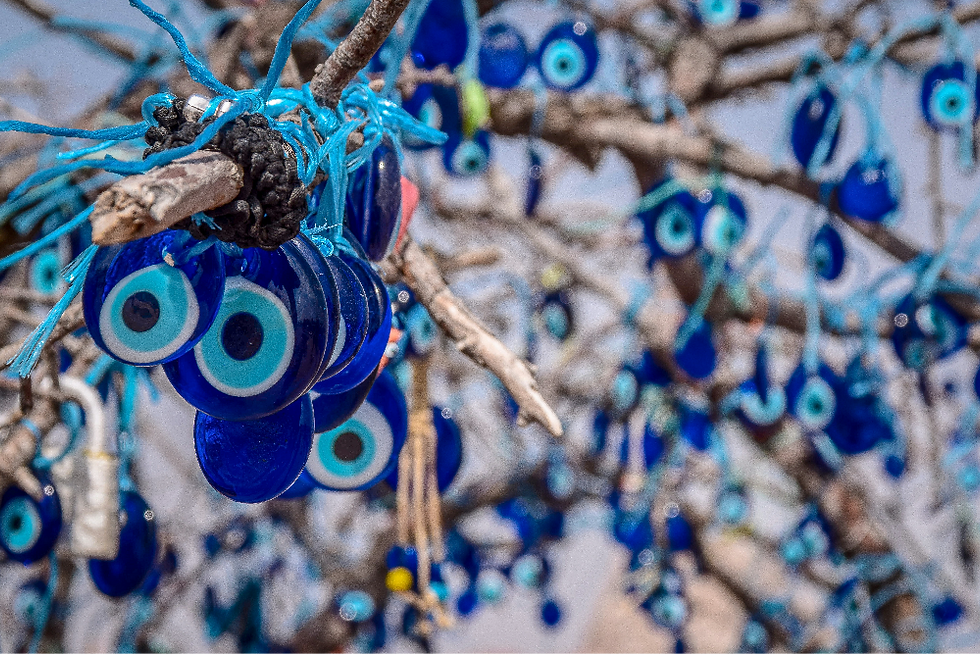What Is the Evil Eye in Greece? Meaning, History, and Traditions
- Greece Media

- Sep 17
- 4 min read
The evil eye, known in Greece as the mati (μάτι, meaning “eye”), is one of the most enduring symbols in Greek culture. It represents the idea that envy or ill will directed at someone can cause them harm, often through bad luck, illness, or misfortune. The belief in the evil eye goes back thousands of years and continues to play an important role in everyday Greek life today.

Origins of the Evil Eye in Greece
The evil eye is not unique to Greece, but the Greek tradition around it is especially strong. References to the evil eye appear in ancient Greek texts, where it was often described as a powerful force caused by envy. Philosophers such as Plutarch wrote about how eyes could release invisible energy that harmed others.
Over time, the belief became deeply woven into Greek folk traditions. The mati symbol, usually a blue eye, emerged as a way to ward off this harmful energy. Greeks believed that wearing or displaying this symbol could reflect the negative energy back to its source.
The Greek Word for Evil Eye: Mati
In Greece, the evil eye is always called the mati. This word is used in everyday speech, whether people are joking about being cursed or seriously describing misfortune.
Common expressions include:
“Με μάτιασες!” (Me mátiases! – “You gave me the evil eye!”)
“Έχει μάτι.” (Éhei máti. – “It has the evil eye.”)
Using the term mati connects the modern belief with centuries of Greek cultural continuity.
How Greeks Protect Themselves from the Evil Eye
Over the years, Greeks developed a variety of customs to protect against the evil eye. Some of the most common include:
1. The Mati Charm
The most recognizable symbol is the blue eye charm, sold in jewelry, wall hangings, and decorations. Blue is considered a protective color that reflects envy away.
2. Spitting Ritual
A traditional response when someone compliments a baby or a bride is to softly spit three times while saying “ftou ftou ftou.” This is not meant as an insult but as protection against envy.
3. Cross and Prayer
Some Greeks make the sign of the cross when they feel the evil eye may be present. There are also special prayers known as xematiasma that can be recited by someone who knows the words, often an elder or priest, to remove the curse.
4. Incense and Oil Rituals
In some regions, drops of olive oil are placed in a glass of water. If the oil spreads unusually, it is believed to confirm the presence of the evil eye.
The Evil Eye in Greek Celebrations and Daily Life
The belief in the evil eye is not limited to rural traditions. It appears everywhere in modern Greece:
Weddings and Baptisms – Guests often give gifts of evil eye jewelry or pins to protect the couple or child.
New Homes and Businesses – Evil eye charms are hung at the entrance to protect the space.
Everyday Fashion – Many Greeks, especially women, wear evil eye necklaces or bracelets daily.
Even those who say they “don’t really believe” often still wear the symbol, just in case.
Why the Evil Eye Symbol Is Blue
Most evil eye charms in Greece are blue. The color blue has been associated with protection since ancient times. Many Greeks believe that blue eyes, especially rare in older generations, were thought to hold strong power and could unintentionally curse others. By using the color blue in charms, people sought to turn this power into protection.
The Evil Eye in Greek Jewelry and Souvenirs
Today, the evil eye is one of the most common souvenirs travelers bring home from Greece. Jewelry shops in Athens, Santorini, Mykonos, and other destinations all display earrings, bracelets, and necklaces featuring the mati.
Beyond jewelry, the evil eye appears on keychains, ceramics, home décor, and even clothing. Its popularity has spread internationally, but its roots in Greek tradition remain strong.
Modern Beliefs About the Evil Eye in Greece
In modern Greece, the evil eye is often treated with a mix of seriousness and humor. Many people genuinely believe in its power, especially in rural areas, while others see it as a cultural symbol that still holds meaning.
It is common to hear someone blame the evil eye for a sudden headache, bad mood, or streak of bad luck. At the same time, younger generations wear the symbol as both a fashion statement and a link to their heritage.
The Evil Eye Beyond Greece
The evil eye belief extends far beyond Greece, appearing in many Mediterranean and Middle Eastern cultures. However, the Greek version, the mati, has become one of the most recognizable worldwide. Tourists often associate the symbol directly with Greece, even though similar beliefs exist in Turkey, Italy, and other regions.
Conclusion: Why the Evil Eye Still Matters in Greece
The evil eye, or mati, remains one of the most enduring aspects of Greek culture. It connects ancient beliefs with modern life, appearing in homes, jewelry, celebrations, and everyday speech. Whether taken as serious protection or simply as tradition, the evil eye continues to shape Greek identity.
For Greeks, wearing or displaying the mati is more than a superstition. It is a reminder of community, heritage, and the unseen forces that people have tried to understand for thousands of years.







